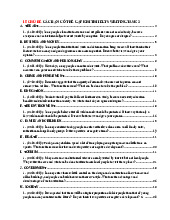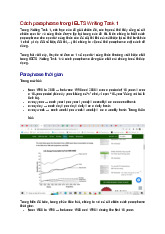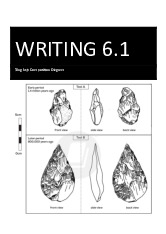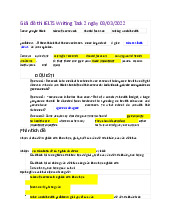



Preview text:
Sample Academic Reading Note Completion
[Note: This is an extract from a Part 1 text about the scientist Marie Curie.]
Adapted with permission from Encyclopaedia Britannica, © 2007 by Encyclopaedia Britannica, Inc.
The life and work of Marie Curie
The marriage of Pierre and Marie Curie in 1895 marked the start of a partnership that was
soon to achieve results of world significance. Following Henri Becquerel’s discovery in 1896
of a new phenomenon, which Marie later called ‘radioactivity’, Marie Curie decided to find
out if the radioactivity discovered in uranium was to be found in other elements. She
discovered that this was true for thorium.
Turning her attention to minerals, she found her interest drawn to pitchblende, a mineral
whose radioactivity, superior to that of pure uranium, could be explained only by the presence
in the ore of small quantities of an unknown substance of very high activity. Pierre Curie
joined her in the work that she had undertaken to resolve this problem, and that led to the
discovery of the new elements, polonium and radium. While Pierre Curie devoted himself
chiefly to the physical study of the new radiations, Marie Curie struggled to obtain pure
radium in the metallic state. This was achieved with the help of the chemist André-Louis
Debierne, one of Pierre Curie’s pupils. Based on the results of this research, Marie Curie
received her Doctorate of Science, and in 1903 Marie and Pierre shared with Becquerel the
Nobel Prize for Physics for the discovery of radioactivity.
The births of Marie’s two daughters, Irène and Eve, in 1897 and 1904 failed to interrupt her
scientific work. She was appointed lecturer in physics at the École Normale Supérieure for
girls in Sèvres, France (1900), and introduced a method of teaching based on experimental
demonstrations. In December 1904 she was appointed chief assistant in the laboratory directed by Pierre Curie.
The sudden death of her husband in 1906 was a bitter blow to Marie Curie, but was also a
turning point in her career: henceforth she was to devote all her energy to completing alone
the scientific work that they had undertaken. On May 13, 1906, she was appointed to the
professorship that had been left vacant on her husband’s death, becoming the first woman to
teach at the Sorbonne. In 1911 she was awarded the Nobel Prize for Chemistry for the
isolation of a pure form of radium.
During World War I, Marie Curie, with the help of her daughter Irène, devoted herself to the
development of the use of X-radiography, including the mobile units which came to be known
as ‘Little Curies’, used for the treatment of wounded soldiers. In 1918 the Radium Institute,
whose staff Irène had joined, began to operate in earnest, and became a centre for nuclear
physics and chemistry. Marie Curie, now at the highest point of her fame and, from 1922, a
member of the Academy of Medicine, researched the chemistry of radioactive substances and their medical applications.
In 1921, accompanied by her two daughters, Marie Curie made a triumphant journey to the
United States to raise funds for research on radium. Women there presented her with a gram
of radium for her campaign. Marie also gave lectures in Belgium, Brazil, Spain and
Czechoslovakia and, in addition, had the satisfaction of seeing the development of the Curie
Foundation in Paris, and the inauguration in 1932 in Warsaw of the Radium Institute, where
her sister Bronia became director.
One of Marie Curie’s outstanding achievements was to have understood the need to
accumulate intense radioactive sources, not only to treat illness but also to maintain an
abundant supply for research. The existence in Paris at the Radium Institute of a stock of 1.5
grams of radium made a decisive contribution to the success of the experiments undertaken in
the years around 1930. This work prepared the way for the discovery of the neutron by Sir
James Chadwick and, above all, for the discovery in 1934 by Irène and Frédéric Joliot-Curie
of artificial radioactivity. A few months after this discovery, Marie Curie died as a result of
leukaemia caused by exposure to radiation. She had often carried test tubes containing
radioactive isotopes in her pocket, remarking on the pretty blue-green light they gave off.
Her contribution to physics had been immense, not only in her own work, the importance of
which had been demonstrated by her two Nobel Prizes, but because of her influence on
subsequent generations of nuclear physicists and chemists. Questions 7 – 6 Complete the notes below.
Choose ONE WORD ONLY from the passage for each answer.
Write your answers in boxes 7-6 on your answer sheet.
Marie Curie’s research on radioactivity
When uranium was discovered to be radioactive, Marie Curie found that the element
called 1 ………… had the same property.
Marie and Pierre Curie’s research into the radioactivity of the mineral known
as 2 ………… led to the discovery of two new elements.
In 1911, Marie Curie received recognition for her work on the element 3 ………… .
Marie and Irène Curie developed X-radiography which was used as a medical
technique for 4 ………… .
Marie Curie saw the importance of collecting radioactive material both for research
and for cases of 5 ………… .
The radioactive material stocked in Paris contributed to the discoveries in the 1930s
of the 6 ………… and of what was known as artificial radioactivity. Questions 7– 9
Complete each sentence with the correct ending, A-F, below.
Write the correct letter, A-F, in boxes 7-9 on your answer sheet. 7
Harkness’s research method was different to that of other writers because 8
Harkness’s reconstruction of the 16th-century London scientific groups was new because 9
Harkness shows that the 16th-century London scientists were innovative because A
she has the greatest knowledge of Elizabethan London. B
she started by seeking to understand how basic terms were used in the past. C
they worked as individuals rather than as a group. D
she examined how their methods evolved and changed. E
Clement Draper was the best scientist of his time. F
they used old ways of analysing written information for new purposes.
Sample Academic Reading Note Completion Answers: 1 thorium 2 pitchblende 3 radium 4 soldiers 5 illness 6 neutron




